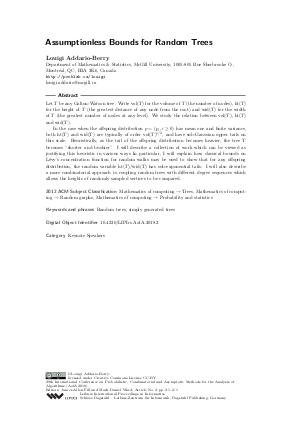Assumptionless Bounds for Random Trees (Keynote Speakers)
Author Louigi Addario-Berry
-
Part of:
Volume:
29th International Conference on Probabilistic, Combinatorial and Asymptotic Methods for the Analysis of Algorithms (AofA 2018)
Part of: Series: Leibniz International Proceedings in Informatics (LIPIcs)
Part of: Conference: International Conference on Probabilistic, Combinatorial and Asymptotic Methods for the Analysis of Algorithms (AofA) - License:
 Creative Commons Attribution 3.0 Unported license
Creative Commons Attribution 3.0 Unported license
- Publication Date: 2018-06-18
File

PDF
LIPIcs.AofA.2018.2.pdf
- Filesize: 188 kB
- 1 pages
Document Identifiers
Subject Classification
ACM Subject Classification
- Mathematics of computing → Trees
- Mathematics of computing → Random graphs
- Mathematics of computing → Probability and statistics
Keywords
- Random trees
- simply generated trees
Metrics
- Access Statistics
-
Total Accesses (updated on a weekly basis)
0PDF Downloads0Metadata Views
Abstract
Let T be any Galton-Watson tree. Write vol(T) for the volume of T (the number of nodes), ht(T) for the height of T (the greatest distance of any node from the root) and wid(T) for the width of T (the greatest number of nodes at any level). We study the relation between vol(T), ht(T) and wid(T).
In the case when the offspring distribution p = (p_i, i >= 0) has mean one and finite variance, both ht(T) and wid(T) are typically of order vol(T)^{1/2}, and have sub-Gaussian upper tails on this scale. Heuristically, as the tail of the offspring distribution becomes heavier, the tree T becomes "shorter and bushier". I will describe a collection of work which can be viewed as justifying this heuristic in various ways In particular, I will explain how classical bounds on Lévy's concentration function for random walks may be used to show that for any offspring distribution, the random variable ht(T)/wid(T) has sub-exponential tails. I will also describe a more combinatorial approach to coupling random trees with different degree sequences which allows the heights of randomly sampled vertices to be compared.
Cite As Get BibTex
Louigi Addario-Berry. Assumptionless Bounds for Random Trees (Keynote Speakers). In 29th International Conference on Probabilistic, Combinatorial and Asymptotic Methods for the Analysis of Algorithms (AofA 2018). Leibniz International Proceedings in Informatics (LIPIcs), Volume 110, p. 2:1, Schloss Dagstuhl – Leibniz-Zentrum für Informatik (2018)
https://doi.org/10.4230/LIPIcs.AofA.2018.2
BibTex
@InProceedings{addarioberry:LIPIcs.AofA.2018.2,
author = {Addario-Berry, Louigi},
title = {{Assumptionless Bounds for Random Trees}},
booktitle = {29th International Conference on Probabilistic, Combinatorial and Asymptotic Methods for the Analysis of Algorithms (AofA 2018)},
pages = {2:1--2:1},
series = {Leibniz International Proceedings in Informatics (LIPIcs)},
ISBN = {978-3-95977-078-1},
ISSN = {1868-8969},
year = {2018},
volume = {110},
editor = {Fill, James Allen and Ward, Mark Daniel},
publisher = {Schloss Dagstuhl -- Leibniz-Zentrum f{\"u}r Informatik},
address = {Dagstuhl, Germany},
URL = {https://drops.dagstuhl.de/entities/document/10.4230/LIPIcs.AofA.2018.2},
URN = {urn:nbn:de:0030-drops-88951},
doi = {10.4230/LIPIcs.AofA.2018.2},
annote = {Keywords: Random trees, simply generated trees}
}
